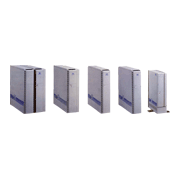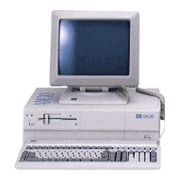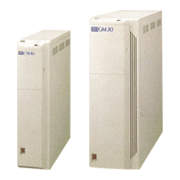These were office computer (*1) series from Uchida Yoko.
The USAC2001 Series (135DB, 68DB, 68MX, 43MX and 20MX) was announced in May 1984, as the successor of the USAC System 5, 9 and 21 office computers-- which could be set up anywhere in an office, and easily operated by anyone when necessary, like an ordinary office machine. When linked with the USAC 230 intelligent workstation and USAC New Camarade (*2), which were announced at the same time, the series went beyond data processing as a single computer, and built the foundation for development into an integrated office system also capable of processing in-office information (data, documents, images etc.) From a systems standpoint too, the series employed a relational database (Smart-MIX) and vertically-distributed processing, and featured a full range of I/O devices, so it helped advance the move toward integrated OA(Office Automation) in the 1980s. These machines had the following features:
(1) They employed the distributed processor system.
(2) They employed a relational database (Smart-MIX)
(3) Processing distribution, data distribution/sharing and OA integrated software linkage were achieved through vertical linkage with intelligent workstations (USAC230, New Camarade)
The USAC2001 VH Series (VH11, VH9, VH7, VH5 and VH3) were announced in May 1986. This series achieved greatly enhanced performance, separation of the console from the engine (main unit), and horizontal linkage between engines (USAC2001 VH Series). The USAC2001 Manager Series, announced in October 1988, aimed to facilitate construction of integrated information management systems for mid-size businesses by further enhancing performance and expandability.
*1: An office computer is a small business computer used in an office.
*2: This machine was called the "New Camarade" to distinguish it from the Camarade announced in 1982.
The M-220X Model, which was the successor of the M-220H, was developed as a computer system for achieving integrated OA systems in the era of "New Media". It came in 4 models, the M-220DX, HX, KX and LX, and enabled switching to a higher end model at the installation site (field upgrading).
The main logic circuits employed 1,500gate/chip high-speed high-density LSI, and peripheral control circuits employed 24,000gate/chip CMOS gate array LSI, with outstanding circuit speed and power consumption. The system also used 256Kbit/chip DRAM. More extensive use of LSI improved reliability and conserved space and power. Further space-savings were achieved by eliminating the need for a special-purpose console.
| USAC2001 Series | USAC2001 VH Series | USAC2001 Manager Series | ||
|---|---|---|---|---|
| Announcement date | May 1984 (Models added in October 1985) | May 1986 (October 1987) | October 1988 | |
| CPU | 16bit CMOS LSI processor (FSSP) | 16bit CMOS LSI processor (FSSPII) | 16bit CMOS LSI processor (FSSPII) | |
| Positioning | Successor of USAC System 5, 9 and 21 | Successor of USAC2001 Series | Successor of USAC2001 VH Series | |
| Main memory | Memory element | 256Kbit DRAM | ||
| Max. capacity | 20MX:1MB 135DB:4MB |
VH3:2MB(II:3.5MB) VH11:7MB(II:12MB) |
AM20:4MB GM70:15MB |
|
| Max. disk capacity | 20MX:40MB 135DB:670MB |
VH3:129MB (II:216MB) VH11:1GB (II:1.3GB) |
AM20:172MB GM70:2.2GB |
|
| Max. number of connected workstations | 20MX:2 135DB:16 |
VH3:2 VH11:24 |
AM20:4 GM70:40 |
|
| Other | Vertically- distributed processing system based on USAC 230/New Camarade Employed relational database |
Enhanced vertical/horizontal linkage functionality Separation of console from engine (main unit) |
Support for new GX Series of workstations | |






